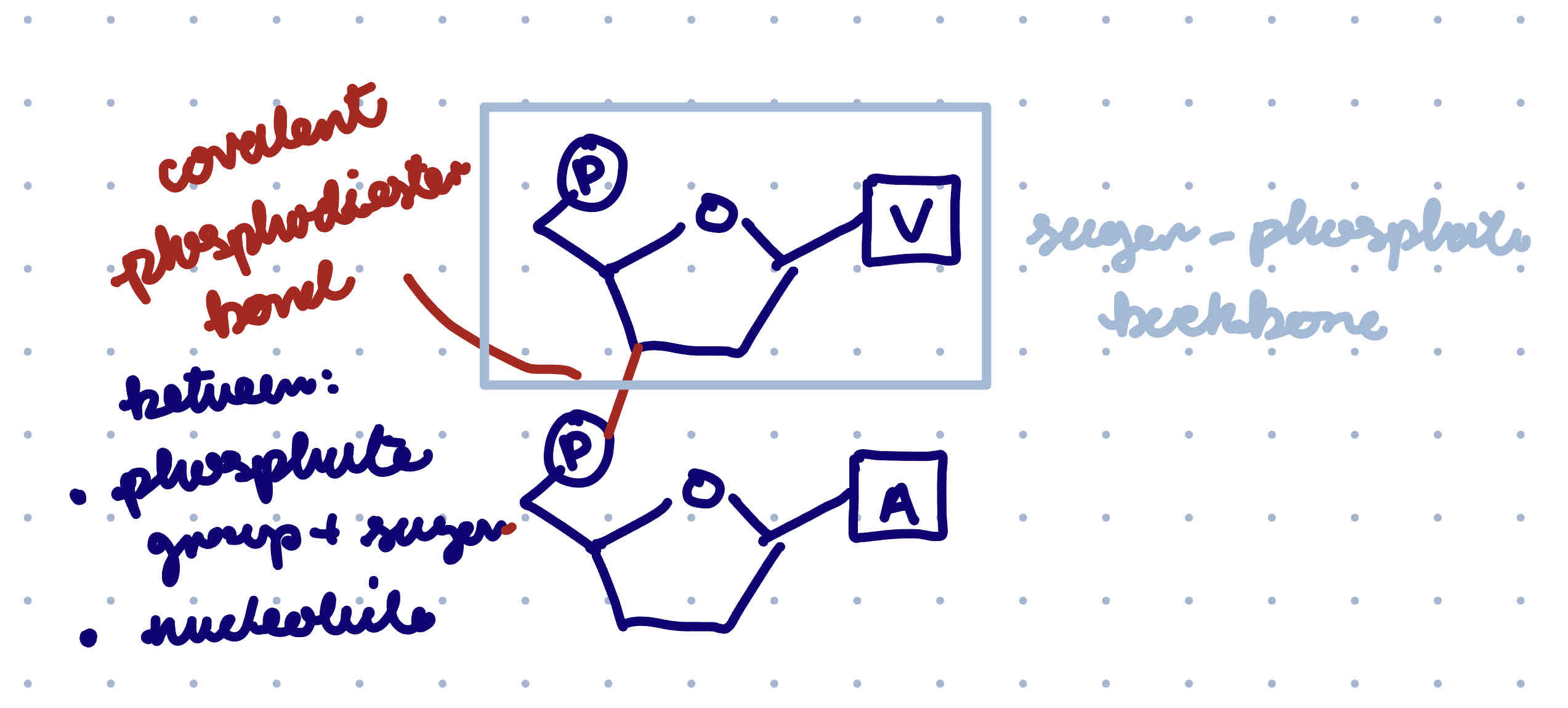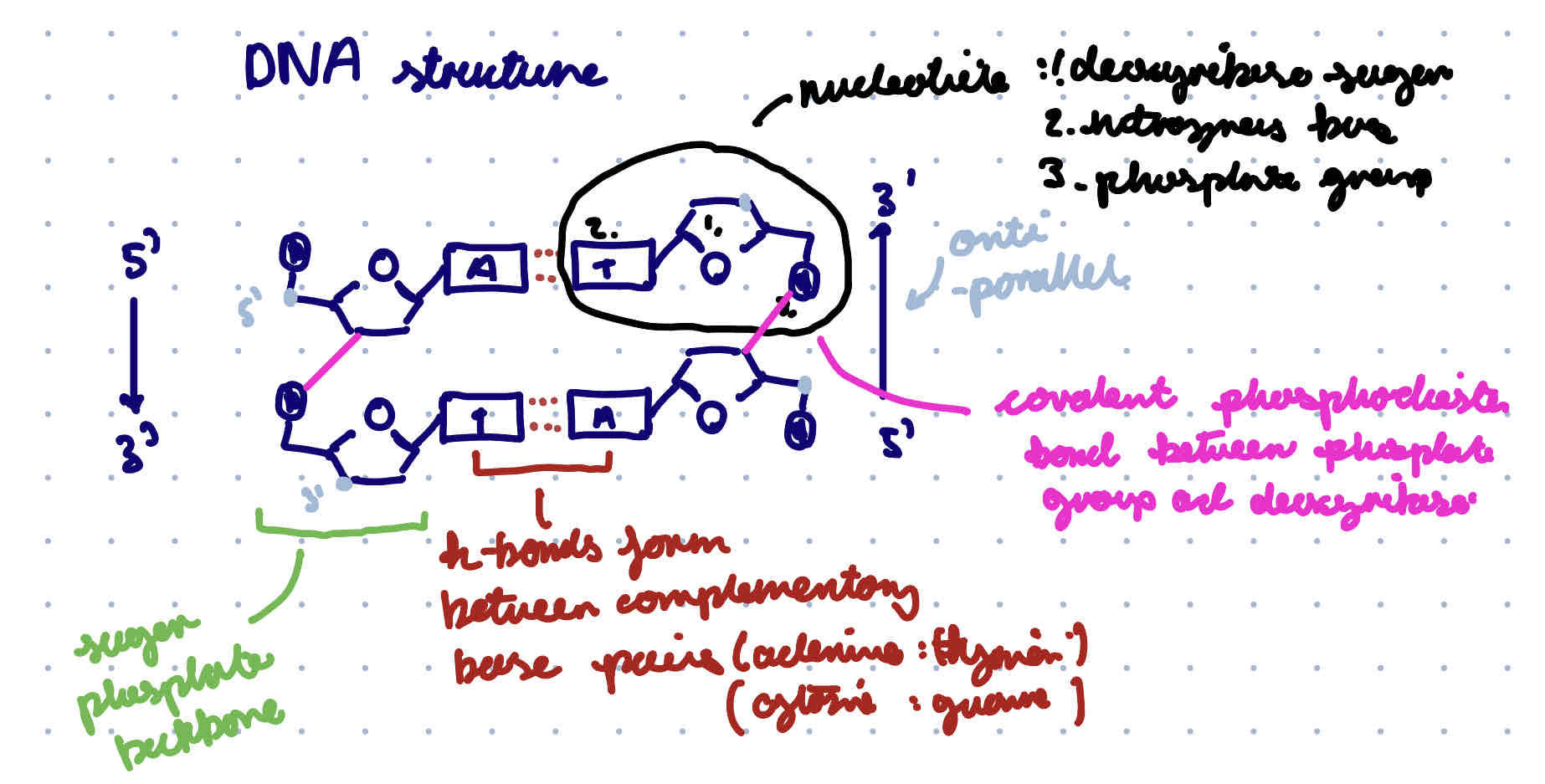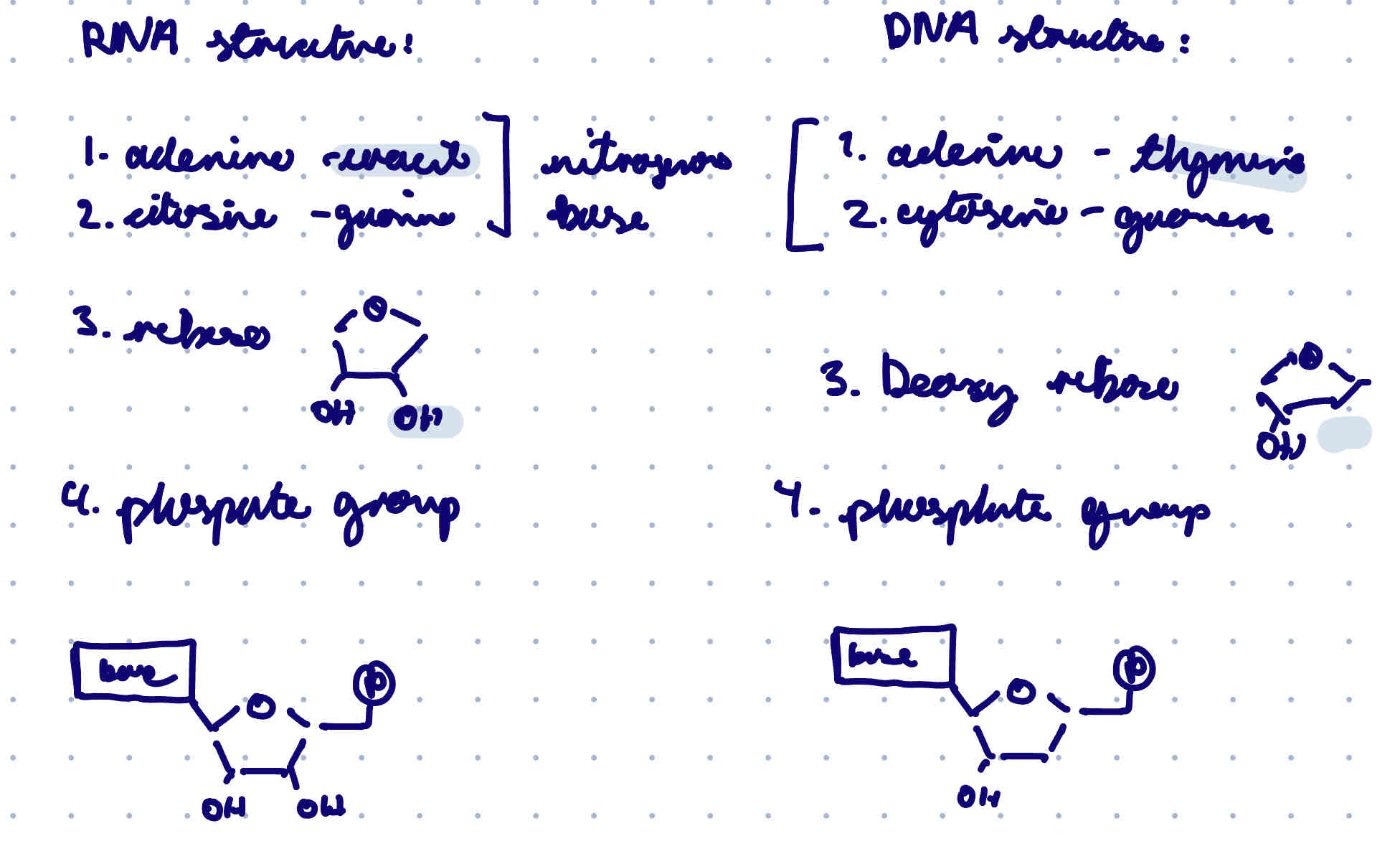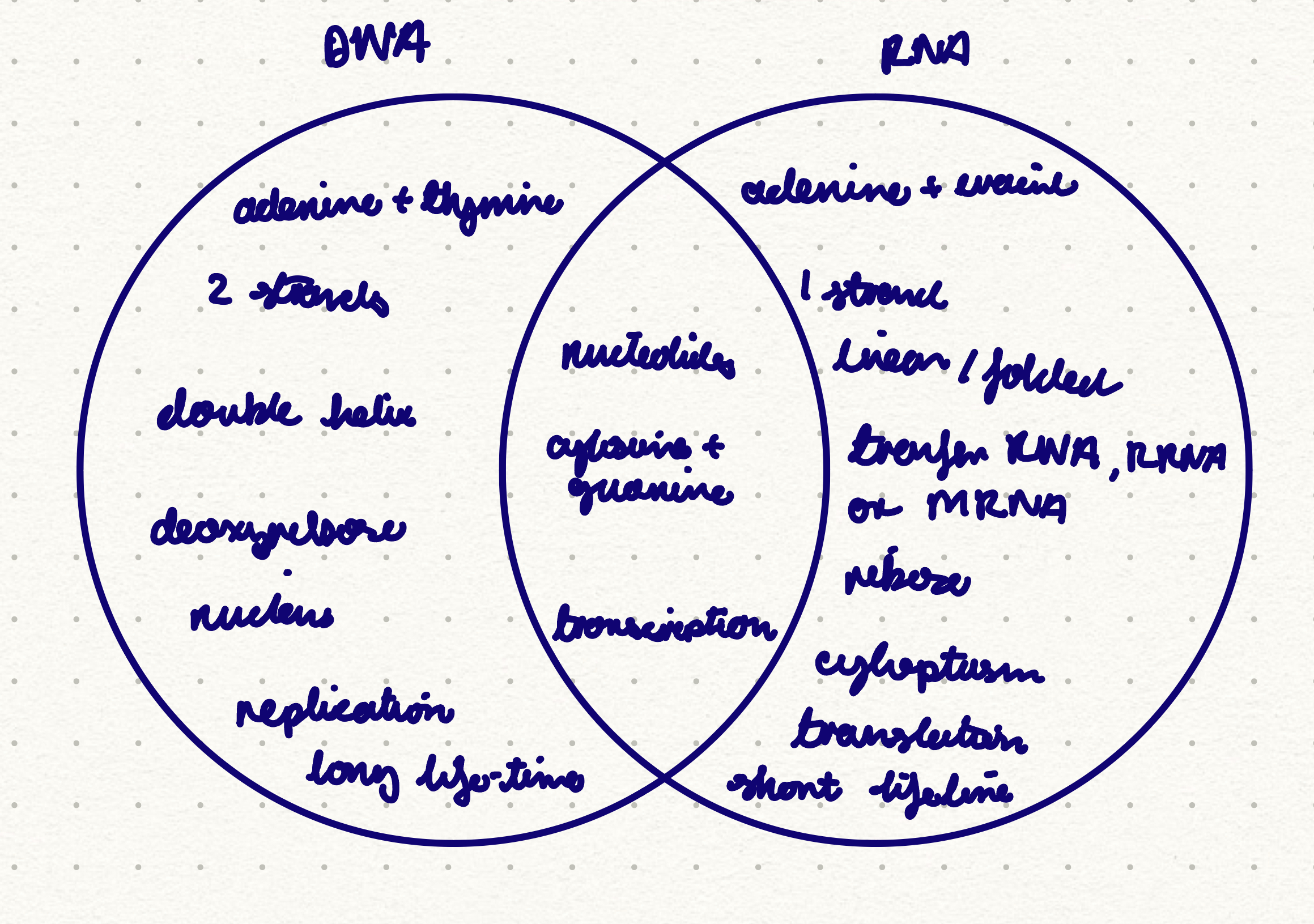A1.2 NUCLEIC ACIDS (copy)
1/13
Earn XP
Description and Tags
Name | Mastery | Learn | Test | Matching | Spaced |
|---|
No study sessions yet.
14 Terms
Define DNA
Deoxyribo nucleic acid
Genetic / hereditary material for all living organisms — passed to offspring
Found in nucleus, mitochondria & chloroplast of eukaryotes, and plasmid & nucleoid of prokaryotes
Genetic code is contained within the nucleic acid
Outline the two types of nucleic acids
DNA & RNA
some viruses use RNA as genetic material, but viruses are not considered to be living
HIV: retrovirus with RNA
Outline the base and genetic code of nucleic acids
The sequence of nitrogenous base pairs/nucleotides in each nucleic acid from the basis of the genetic code
Bases in DNA:
Adenine and thymine
Guanine and cytosine
Bases in RNA
Adenine and uracil
Guanine and cytosine
The genetic code is universal to all organisms with three bases pair sequences called codons, andwhich correspond to the sameaminoacid in nearly all organisms
Describe the components of nucleotide, and the formation of the nucleic acids DNA and RNA
NUCLEOTIDES:
Pentose 5-C sugar (either ribose RNA OR deoxyribose DNA) — DNA & RNA are polymers of nucleotides
Phosphate group
Nitrogenous base
STRUCTURE & FORMATION OF DNA/RNA:
Made through condensation reactions to join nucleotides to a growing chain → forms phosphodiester bond (and water)
New nucleotides are added to the 3’ carbon of the sugar in the 5’ to 3’ direction
Sugar: phosphate backbone on the outside
Nitrogenous bases are on the inside

Outline the structure of DNA
Double stranded molecule → forms doublehelix that wraps around each other regularly
Nucleotides are the subunits, and DNA is a polymer of nucleotides
Hydrogenbonds from between complementary base pairs (adenine & thymine, cytosine & guanine) and covalentbonds form between phosphate group and sugar
The sugar-phosphate backbone is on the outside (of dna and rna)
Strands are anti-parallel (5’ - 3’ one way, 3’ to 5’ other way) → linear strands of DNA are formed in eukaryotes and circular DNA is found in prokaryotes

Draw the structure & similarities of the nucleotides DNA and RNA

Compare and contrast DNA and RNA

Outline the role of complementary base pairing in the replication of genetic information and expression
Complementary base pairing between nitrogenous bases allows for genetic information to be replicated (DNA replication) and expressed (transcription of DNA to form mRNA and translation of protein synthesis using mRNA strand)
Hydrogen bonds form between complementary base pairs: Adenine pairs with thymine (DNA) or uracil (RNA)/ cytosine pairs with guanine
REPLICATION: DNA polymerase III adds new DNA nucleotides (polymerise, elongate) to the growing stand between the old template and the new strand
Adds in the 5’ to 3’ direction to the 3’ end
Adds nucleotides based on complementary base pairing
Occurs when the cell divides, in the s-phase (interphase) of the cell cycle
Produces identical copies of DNA
TRANSCRIPTION: RNA polymerase adds new RNA nucleotides to the growing mRNA stand based on the pairing between the template/antisense strand of DNA and mRNA
Adds in the 5’ to 3’ direction to the 3’ end
Adds nucleotides based on complementary base pairing
Produces mRNA from DNA
TRANSLATION: Complementary base pairing between codons in mRNA and anticodons tRNA
Produces proteins from mRNA strand
Ribosome moves in the 5’ to 3’ direction of mRNA
Information in mRNA is used to bring amino acids & bring them together to form a polypeptide/proteins
Outline the diversity of possible DNA base sequences and the limitless capacity of DNA for information storage
DNA is an information storage molecule
DNA is a molecule of hereditary: information is passed to offspring — in DNA replication, info is stored in DNA and passed from cell to cell
Information is translated into protein through synthesis — a sequence of nitrogenous bases form a code that stores information used to make proteins
Diversity by any length of DNA and any base sequence/order:
Four bases: adenine, thymine, cytosine, guanine
Possibilities are 4^n, where n = length of DNA
Outline the conservation of genetic code across all life forms as evidence of universal common ancestry
All living organisms have DNA as the molecule of hereditary
The genetic information is conserved in the genetic code of all living organisms
The genetic code is universal and evidence for a universal common ancestor (LUCA)
Outline the purine-to-pyrimidine bonding as a component of DNA helix stability
There are two types of nucleotides: purine and pyrimidines
Purines form hydrogen bonds with pyrimidines by complementary base pairing
Adenine forms 2 hydrogen bonds with thymine
Guanine forms 3 hydrogen bonds with cytosnie
Purine to pyrimidine (hydrogen bonding) allows for DNA helix stability → maintains consistent width
purine + purine → too wide
pyrimidines + pyrimidines → too narrow
Describe the structure & function of a nucleosome
Nucleosomes are structural units that organise DNA
Nucleosomes condense the size of DNA by 8,000x
Nucleosomes are 8 histone proteins and a linker histone protein that connects nucleosomes together
DNA is wrapped twice around the nucleosomes
The positively charged histone proteins electro-statically bind to the negatively charged phosphates in DNA
Discuss the Hershey-Chase experiment
Wanted to determine if protein or DNA was the molecule of heredity
Viruses/bacteriophages were labelled with radioactive isotopes → infect cells and inject their genetic material
Radioactive phosphorus was incorporated into DNA
Radioactive sulphur was incorporated into proteins
Centrifugation separates the supernatant (phage) from the pellet (bacteria)
Radioactive labelled protein (coat/capsid) remains in the supernatant → protein isn’t injected as the hereditary molecule
Radioactively labelled DNA is found in the pellet → entered the cell → DNA is responsible for hereditary
Discuss Chargaff’s data on the relative amounts of pyrimidine and purine bases across diverse life forms
Erwin Chargraff analysed the chemical composition of A,T,C,and G bases from DNA of different species
Bases were not in equal quantities
The number of bases differed between the species, but not within a species → contributed to the idea that DNA is genetic material
The amount of A=T and the amount of C=G (the purine to pyrimidine ratio equals 1)